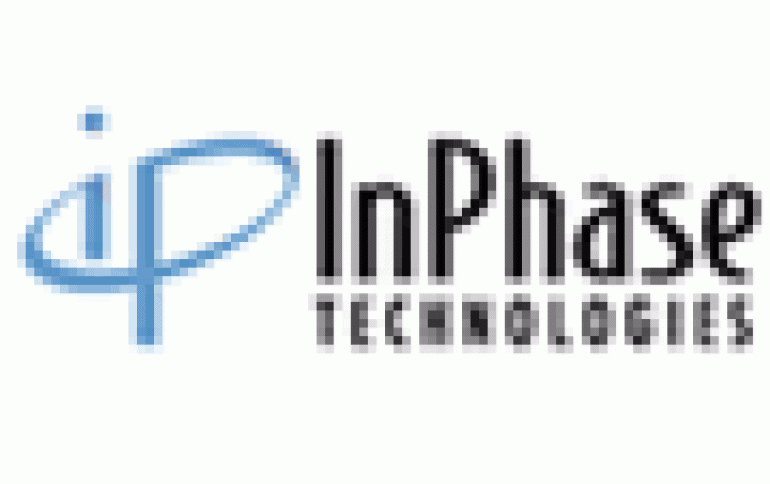
InPhase to Showcase First Commercial Holographic Storage Drive in Europe
The InPhase Tapestry drive, a breakthrough in data storage that has now reached prototype phase, will be demonstrated publicly in Europe for the first time at the International Broadcasters Conference (IBC) in Amsterdam, September 9-13.
The initial InPhase Tapestry product will hold 300 gigabytes (GB) of data with a transfer rate of 20
megabytes (MB) per second, making it ideal for high-definition recording. InPhase is targeting archive
needs in commercial markets such as professional video, regulatory compliance, medical imaging,
satellite imaging, and scientific applications where the need for long-term and secure
archives of massive amounts of digital data is a critical issue.
How is data recorded?
Light from a single laser beam is split into two beams, the signal beam (which carries the data) and the reference beam. The hologram is formed where these two beams intersect in the recording medium.
The process for encoding data onto the signal beam is accomplished by a device called a spatial light modulator (SLM). The SLM translates the electronic data of 0's and 1's into an optical "checkerboard" pattern of light and dark pixels. The data is arranged in an array or page of around a million bits. The exact number of bits is determined by the pixel count of the SLM.
At the point of intersection of the reference beam and the data carrying signal beam, the hologram is recorded in the light sensitive storage medium. A chemical reaction occurs in the medium when the bright elements of the signal beam intersect the reference beam, causing the hologram stored. By varying the reference beam angle, wavelength, or media position many different holograms can be recorded in the same volume of material.

Holographic storage delivers high capacity by recording data throughout the volume of the recording material, and not just on the surface. A data page of approximately 1 million bits is recorded in one flash of the laser. Each data page is located at a unique address within the material and several hundred pages of data, each with their own unique address, are recorded in the same location of the medium. A collection of data pages is referred to as a book. This new recording technique enables more holograms to be stored in the same volume of material by overlapping not only pages, but also books of data. This dramatically increases the storage density.
The company said that it will use a high-speed custom complementary metal oxide semiconductor (CMOS) camera chip developed by Cypress Semiconductor, for the world's first holographic storage drive. The Cypress chip is an ultrafast CMOS image sensor, and is expected to enable high-speed reading of data (at 500 frames per second) recorded by the InPhase Tapestry drive.
The Cypress CMOS imager features a digital interface and is sized with a pixel count of 1696 X 1710 and a pixel pitch of 8 microns. The InPhase Tapestry drive will direct the frame of data to enable a faster readout of information.
"We are literally redefining how information is stored and read for the next generation of recording devices, and the addition of Cypress's imaging expertise to the development of the first holographic drive is critical," said Nelson Diaz, CEO of InPhase. "We believe that this new architecture will help speed the development of new classes of devices that rely on holographic recording - whether for cameras, video recorders or editing systems."
The International Broadcasters Conference (IBC) is held in Amsterdam, September 9-13. The InPhase tapestry drive will be showcased in the Hitachi Denshi/Maxell stand, 11.730.
How is data recorded?
Light from a single laser beam is split into two beams, the signal beam (which carries the data) and the reference beam. The hologram is formed where these two beams intersect in the recording medium.
The process for encoding data onto the signal beam is accomplished by a device called a spatial light modulator (SLM). The SLM translates the electronic data of 0's and 1's into an optical "checkerboard" pattern of light and dark pixels. The data is arranged in an array or page of around a million bits. The exact number of bits is determined by the pixel count of the SLM.
At the point of intersection of the reference beam and the data carrying signal beam, the hologram is recorded in the light sensitive storage medium. A chemical reaction occurs in the medium when the bright elements of the signal beam intersect the reference beam, causing the hologram stored. By varying the reference beam angle, wavelength, or media position many different holograms can be recorded in the same volume of material.

Holographic storage delivers high capacity by recording data throughout the volume of the recording material, and not just on the surface. A data page of approximately 1 million bits is recorded in one flash of the laser. Each data page is located at a unique address within the material and several hundred pages of data, each with their own unique address, are recorded in the same location of the medium. A collection of data pages is referred to as a book. This new recording technique enables more holograms to be stored in the same volume of material by overlapping not only pages, but also books of data. This dramatically increases the storage density.
The company said that it will use a high-speed custom complementary metal oxide semiconductor (CMOS) camera chip developed by Cypress Semiconductor, for the world's first holographic storage drive. The Cypress chip is an ultrafast CMOS image sensor, and is expected to enable high-speed reading of data (at 500 frames per second) recorded by the InPhase Tapestry drive.
The Cypress CMOS imager features a digital interface and is sized with a pixel count of 1696 X 1710 and a pixel pitch of 8 microns. The InPhase Tapestry drive will direct the frame of data to enable a faster readout of information.
"We are literally redefining how information is stored and read for the next generation of recording devices, and the addition of Cypress's imaging expertise to the development of the first holographic drive is critical," said Nelson Diaz, CEO of InPhase. "We believe that this new architecture will help speed the development of new classes of devices that rely on holographic recording - whether for cameras, video recorders or editing systems."
The International Broadcasters Conference (IBC) is held in Amsterdam, September 9-13. The InPhase tapestry drive will be showcased in the Hitachi Denshi/Maxell stand, 11.730.





















